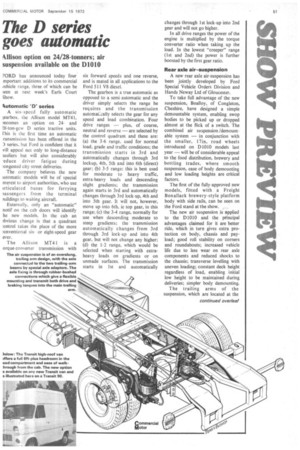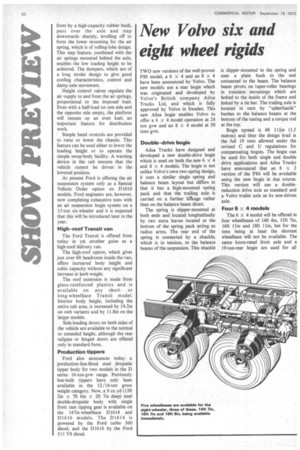The D series goes automatic
Page 53

Page 54

If you've noticed an error in this article please click here to report it so we can fix it.
Allison option on 24/28-tonners; air suspension available on the D1010
FORD has announced today four mportant additions to its commercial /allele range, three of which can be ;een at next week's Earls Court show.
tkutomatic "113 series
A six-speed fully automatic ;earbox, the Allison model MT41, )ecomes an option on 24and ?.8-ton-gcw D series tractive units. Phis is the first time an automatic ran smission has been offered in the 3 series, but Ford is confident that it vill appeal not only to long-distance muliers but will also considerably .educe driver fatigue during ;ongested city street deliveries.
The company believes the new lutomatie models will be of special nterest to airport authorities, who use trticulated buses for ferrying )assengers from the terminal mildings to waiting aircraft.
Externally, only an "automatic" notif on the cab doors will identify he new models. In the cab an thvious change is that a quadrant :ontrol takes the place of the more :onventional sixor eight-speed gear ever.
The Allison MT41 is a orque-converter transmission with six forward speeds and one reverse, and is mated in all applications to the Ford 511 V8 diesel.
The gearbox is a true automatic as opposed to a semi-automatic and the driver simply selects the range he requires and the transmission automat:zally selects the gear for any speed and load combination. Four drive ranges — plus, of course, neutral and reverse — are selected by the control quadrant and these are: (a) the 3-6 range, used for normal load, grade and traffic conditions; the transmission starts in 3rd and automatically changes through 3rd lockup, 4th, 5th and into 6th (direct) gear; (b) 3-5 range: this is best used for moderate to heavy traffic, extra-heavy loads and descending slight gradients; the transmission again starts in 3rd and automatically changes through 3rd lock-up, 4th and into 5th gear. It will not, however, move up into 6th, ie top gear, in this range; (c) the 3-4 range, normally for use when descending moderate to steep gradients; the transmission automatically 'changes from 3rd through 3rd lock-up and into 4th gear, but will not change any higher; (d) the 1-2 range, which would be selected when starting with extraheavy loads on gradients or on unmade surfaces. The transmission starts in 1st and automatically changes through 1st lock-up into 2nd gear and will not go higher.
In all drive ranges the power of the engine is multiplied by the torque converter ratio when taking up the load. In the lowest "creeper" range (1st and 2nd) the power is further boosted by the first gear ratio.
Rear axle air-suspension
A new rear axle air-suspension has been jointly developed by Ford Special Vehicle Orders Division and Hands Neway Ltd of Gloucester.
To take full advantage of the new suspension, Boalloy, of Congleton, Cheshire, have designed a simple demountable system, enabling swop bodies to be picked up or dropped almost at the flick of a switch. The combined air suspension /demountable system — in conjunction with the smaller, 17in, road wheels introduced on D1010 models last year — will be of considerable appeal to the food distribution, brewery and bottling trades, where smooth suspension, ease of body demounting and low loading heights are critical factors.
The first of the fully-approved new models, fitted with a Freight Bonallack brewery-style platform body with side rails, can be seen on the Ford stand at the show.
The new air suspension is applied to the D1010 and the ptincipal advantages claimed for it are better ride, which in turn gives extra protection on body, chassis and payload; good roll stability on corners and roundabouts; increased vehicle life due to less wear on rear axle components and reduced shocks to the chassis; transverse levelling with uneven loading; constant deck height regardless of load, enabling initial low height to be maintained during deliveries; simpler body demounting.
The trailing arms of the suspension, which are located at the front by a high-capacity rubber bush, pass over the axle and step downwards sharply, levelling off to form the lower mounting for the air spring, which is of rolling-lobe design. This step feature, combined with the air springs mounted behind the axle, enables the low loading height to be achieved. The dampers, which are of a long stroke design to give good cooling characteristics, control and damp axle movement.
Height control valves regulate the air supply to and from the air springs, proportional to the imposed load. Even with a half-load on one side and the opposite side empty, the platform will remain on an even keel, an important feature for distribution work.
Simple hand controls are provided to raise or lower the chassis. This feature can be used either to lower the loading height or to operate the simple swop-body facility. A warning device in the cab ensures that the vehicle cannot be driven in the lowered position.
At present Ford is offering the air suspension system only as a Special Vehicle Order option on D1010 models. Ford engineers are, however, now completing exhaustive tests with an air suspension bogie system on a 13-ton six-wheeler and it is expected that this will be introduced later in the year.
High-roof Transit van The Ford Transit is offered from today in yet another guise as a high-roof delivery van.
The high-roof option, which gives just over fift headroom inside the van, offers increased body height and cubic capacity without any significant increase in kerb weight.
The roof extension is made from glass-reinforced plastics and is available on any shortor long-wheelbase Transit model. Interior body height, including the entire cab area, is increased by 19.3in on swb variants and by 11.8in on the larger models.
Side-loading doors on both sides of the vehicle are available to the normal or extended height, although the rear tailgate or hinged doors are offered only in standard form.
Production tippers Ford also announces today a production-line-fitted steel dropside tipper body for two models in the D series 16-ton-gvw range. Previously line-built tippers have only been available in the 12/14-ton gross weight category. Now, a 9 cu yd (13ft 2in x 7ft 6in X 2ft 7in deep) steel double-dropside body with single front ram tipping gear is available on the 147in-wheelbase D1614 and D1616 models. The D1614 is powered by the Ford turbo 360 diesel, and the D1616 by. the Ford 511 V8 diesel.
























































































































